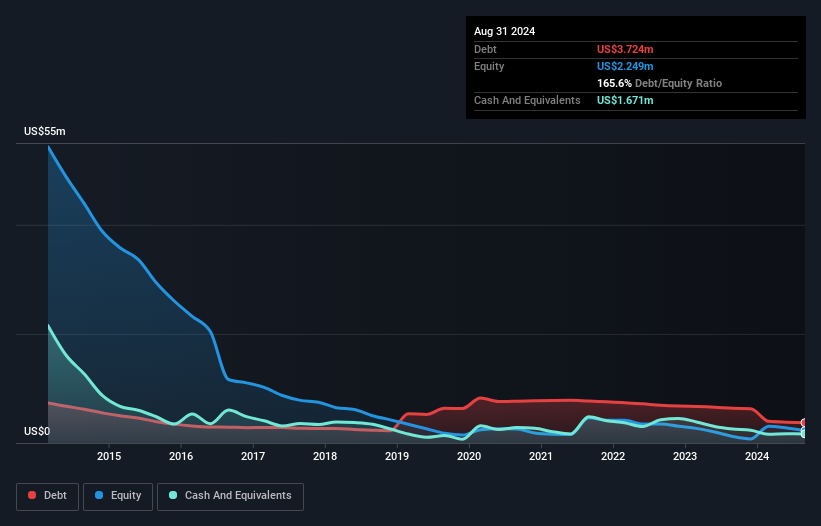Here's Why SemiLEDs (NASDAQ:LEDS) Can Afford Some Debt
Here's Why SemiLEDs (NASDAQ:LEDS) Can Afford Some Debt
Some say volatility, rather than debt, is the best way to think about risk as an investor, but Warren Buffett famously said that 'Volatility is far from synonymous with risk.' When we think about how risky a company is, we always like to look at its use of debt, since debt overload can lead to ruin. Importantly, SemiLEDs Corporation (NASDAQ:LEDS) does carry debt. But the more important question is: how much risk is that debt creating?
有些人认为波动性,而不是债务,是投资者思考风险的最佳方式,但沃伦·巴菲特曾说过:‘波动性远不是风险的同义词。’ 当我们考虑公司的风险时,我们总是喜欢关注它的债务使用情况,因为债务过重可能导致破产。重要的是,旭明光电(纳斯达克:LEDS)确实负债。但更重要的问题是:这些债务造成了多少风险?
Why Does Debt Bring Risk?
为什么债务会带来风险?
Debt and other liabilities become risky for a business when it cannot easily fulfill those obligations, either with free cash flow or by raising capital at an attractive price. Ultimately, if the company can't fulfill its legal obligations to repay debt, shareholders could walk away with nothing. However, a more frequent (but still costly) occurrence is where a company must issue shares at bargain-basement prices, permanently diluting shareholders, just to shore up its balance sheet. Having said that, the most common situation is where a company manages its debt reasonably well - and to its own advantage. When we examine debt levels, we first consider both cash and debt levels, together.
当一家公司无法轻松履行债务和其他义务时,这些义务就变得风险重重,既无法用自由现金流偿还,也无法以有吸引力的价格融资。最终,如果公司无法履行法定的还债义务,股东可能一无所获。然而,更常见(但仍然昂贵)的情况是,公司必须以极低的价格发行股票,永久稀释股东权益,仅仅是为了增强其资产负债表。话虽如此,最常见的情况是公司合理管理其债务,并从中获益。当我们检查债务水平时,我们首先考虑现金和债务水平。
How Much Debt Does SemiLEDs Carry?
旭明光电负债多少?
You can click the graphic below for the historical numbers, but it shows that SemiLEDs had US$3.72m of debt in August 2024, down from US$6.37m, one year before. However, because it has a cash reserve of US$1.67m, its net debt is less, at about US$2.05m.
您可以点击下面的图表查看历史数据,但它显示旭明光电在2024年8月的债务为372万美元,比一年前的637万美元有所减少。然而,由于它有167万美元的现金储备,其净债务较少,约为205万美元。

How Strong Is SemiLEDs' Balance Sheet?
旭明光电的资产负债表有多强?
Zooming in on the latest balance sheet data, we can see that SemiLEDs had liabilities of US$7.02m due within 12 months and liabilities of US$1.87m due beyond that. Offsetting this, it had US$1.67m in cash and US$416.0k in receivables that were due within 12 months. So its liabilities total US$6.80m more than the combination of its cash and short-term receivables.
深入了解最新的资产负债表数据,我们可以看到旭明光电在12个月内有702万美元的负债,而在更长期内有187万美元的负债。相抵的是,它在现金中有167万美元,以及在12个月内到期的应收款41.6万美元。所以,其负债总额比现金和短期应收款总额多出680万美元。
This is a mountain of leverage relative to its market capitalization of US$9.30m. Should its lenders demand that it shore up the balance sheet, shareholders would likely face severe dilution. There's no doubt that we learn most about debt from the balance sheet. But it is SemiLEDs's earnings that will influence how the balance sheet holds up in the future. So if you're keen to discover more about its earnings, it might be worth checking out this graph of its long term earnings trend.
相对于其930万美元的市值,这是一座巨额的杠杆。如果其贷方要求它巩固资产负债表,股东可能会面临严重的摊薄。毫无疑问,我们从资产负债表中了解到大部分关于债务的信息。但影响资产负债表未来表现的将是旭明光电的盈利。所以,如果你想了解更多关于其盈利的信息,查看这张其长期盈利趋势的图表可能会值得。
In the last year SemiLEDs had a loss before interest and tax, and actually shrunk its revenue by 13%, to US$5.2m. That's not what we would hope to see.
在过去的一年里,旭明光电在利息和税前亏损,营业收入实际上减少了13%,降至520万美元。这并不是我们希望看到的。
Caveat Emptor
买方自负。
Not only did SemiLEDs's revenue slip over the last twelve months, but it also produced negative earnings before interest and tax (EBIT). Indeed, it lost a very considerable US$3.0m at the EBIT level. When we look at that and recall the liabilities on its balance sheet, relative to cash, it seems unwise to us for the company to have any debt. Quite frankly we think the balance sheet is far from match-fit, although it could be improved with time. However, it doesn't help that it burned through US$517k of cash over the last year. So in short it's a really risky stock. When analysing debt levels, the balance sheet is the obvious place to start. But ultimately, every company can contain risks that exist outside of the balance sheet. For example, we've discovered 4 warning signs for SemiLEDs (2 are significant!) that you should be aware of before investing here.
不仅旭明光电的营业收入在过去12个月间下降,而且它的利息和税前利润(EBIT)也为负值。实际上,在EBIT层面上,它损失了相当可观的300万美元。当我们看到这些数据并回忆起其资产负债表上的负债时,相对于现金,企业负债似乎是不明智的。坦率地说,我们认为资产负债表远未达到理想状态,尽管随着时间的推移可能会有所改善。然而,过去一年里它消耗了51.7万美元的现金,这并没有帮助。因此,总而言之,这是一只非常高风险的股票。在分析债务水平时,资产负债表无疑是最明显的切入点。但归根结底,每家公司都可能存在资产负债表之外的风险。例如,我们发现了旭明光电的4个警告信号(其中2个是重要的!),在投资之前你应该注意这些。
If, after all that, you're more interested in a fast growing company with a rock-solid balance sheet, then check out our list of net cash growth stocks without delay.
如果在所有这些之后,您更感兴趣的是具有坚实资产负债表的快速增长公司,那么不要拖延,查看我们的净现金增长股票列表。
Have feedback on this article? Concerned about the content? Get in touch with us directly. Alternatively, email editorial-team (at) simplywallst.com.
This article by Simply Wall St is general in nature. We provide commentary based on historical data and analyst forecasts only using an unbiased methodology and our articles are not intended to be financial advice. It does not constitute a recommendation to buy or sell any stock, and does not take account of your objectives, or your financial situation. We aim to bring you long-term focused analysis driven by fundamental data. Note that our analysis may not factor in the latest price-sensitive company announcements or qualitative material. Simply Wall St has no position in any stocks mentioned.
对这篇文章有反馈吗?对内容感到担忧吗?请直接与我们联系。或者,发送电子邮件至editorial-team @ simplywallst.com。
Simply Wall St的这篇文章是一般性质的。我们仅基于历史数据和分析师预测提供评论,使用公正的方法,我们的文章并非意在提供财务建议。这并不构成买入或卖出任何股票的建议,并且不考虑您的目标或财务状况。我们旨在为您带来基于基础数据驱动的长期聚焦分析。请注意,我们的分析可能未考虑最新的价格敏感公司公告或定性材料。Simply Wall St对提及的任何股票都没有持仓。

 Zooming in on the latest balance sheet data, we can see that SemiLEDs had liabilities of US$7.02m due within 12 months and liabilities of US$1.87m due beyond that. Offsetting this, it had US$1.67m in cash and US$416.0k in receivables that were due within 12 months. So its liabilities total US$6.80m more than the combination of its cash and short-term receivables.
Zooming in on the latest balance sheet data, we can see that SemiLEDs had liabilities of US$7.02m due within 12 months and liabilities of US$1.87m due beyond that. Offsetting this, it had US$1.67m in cash and US$416.0k in receivables that were due within 12 months. So its liabilities total US$6.80m more than the combination of its cash and short-term receivables.